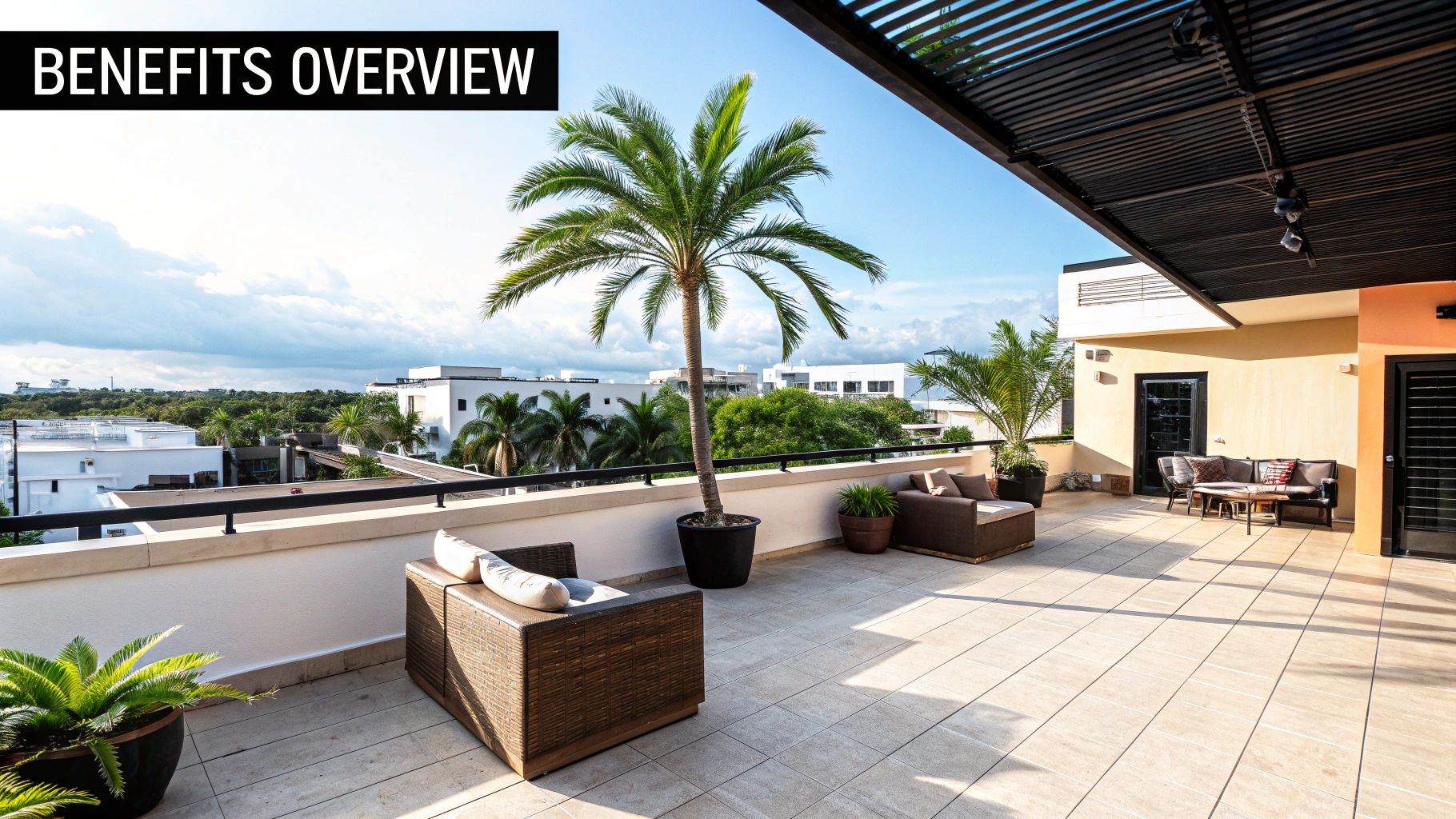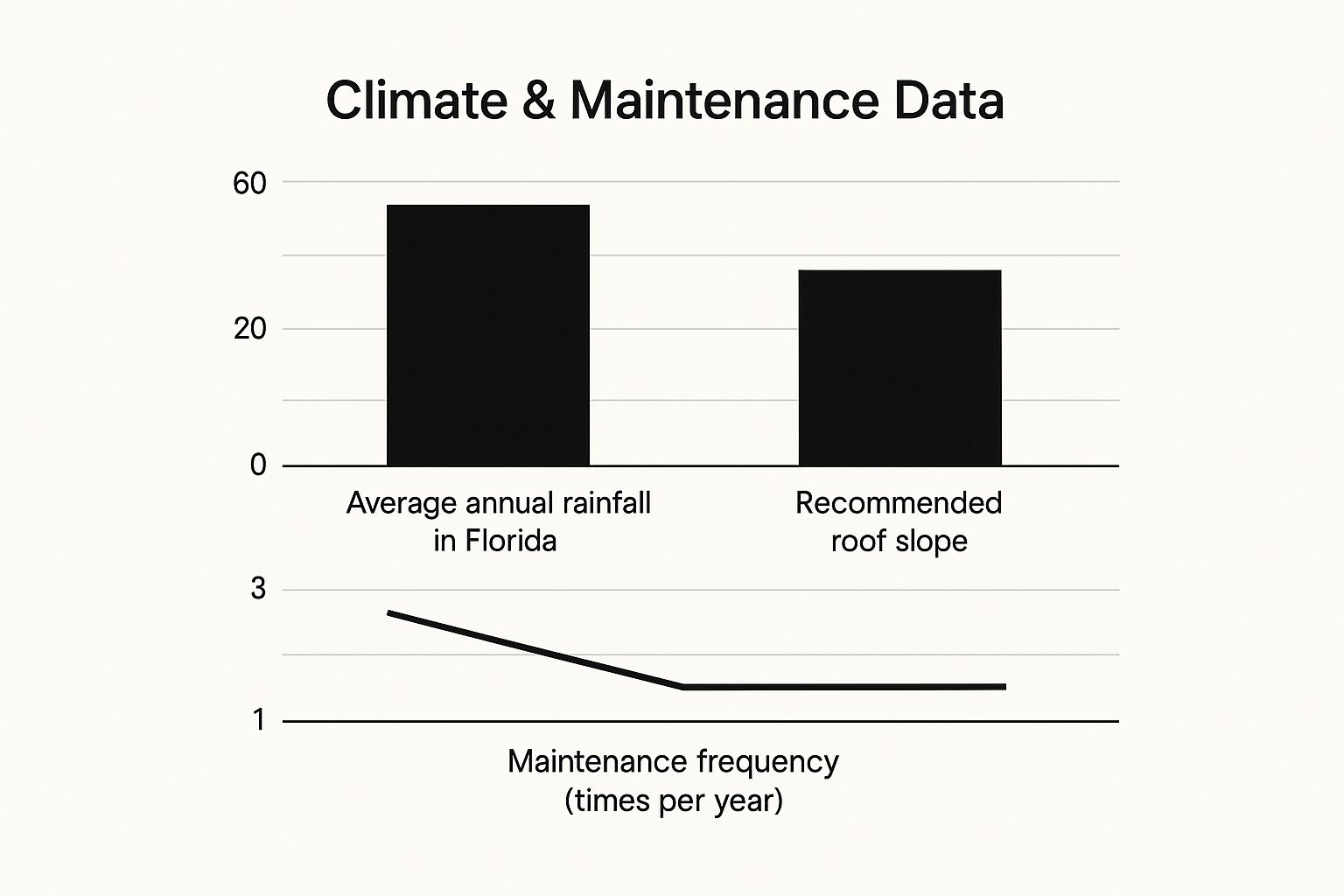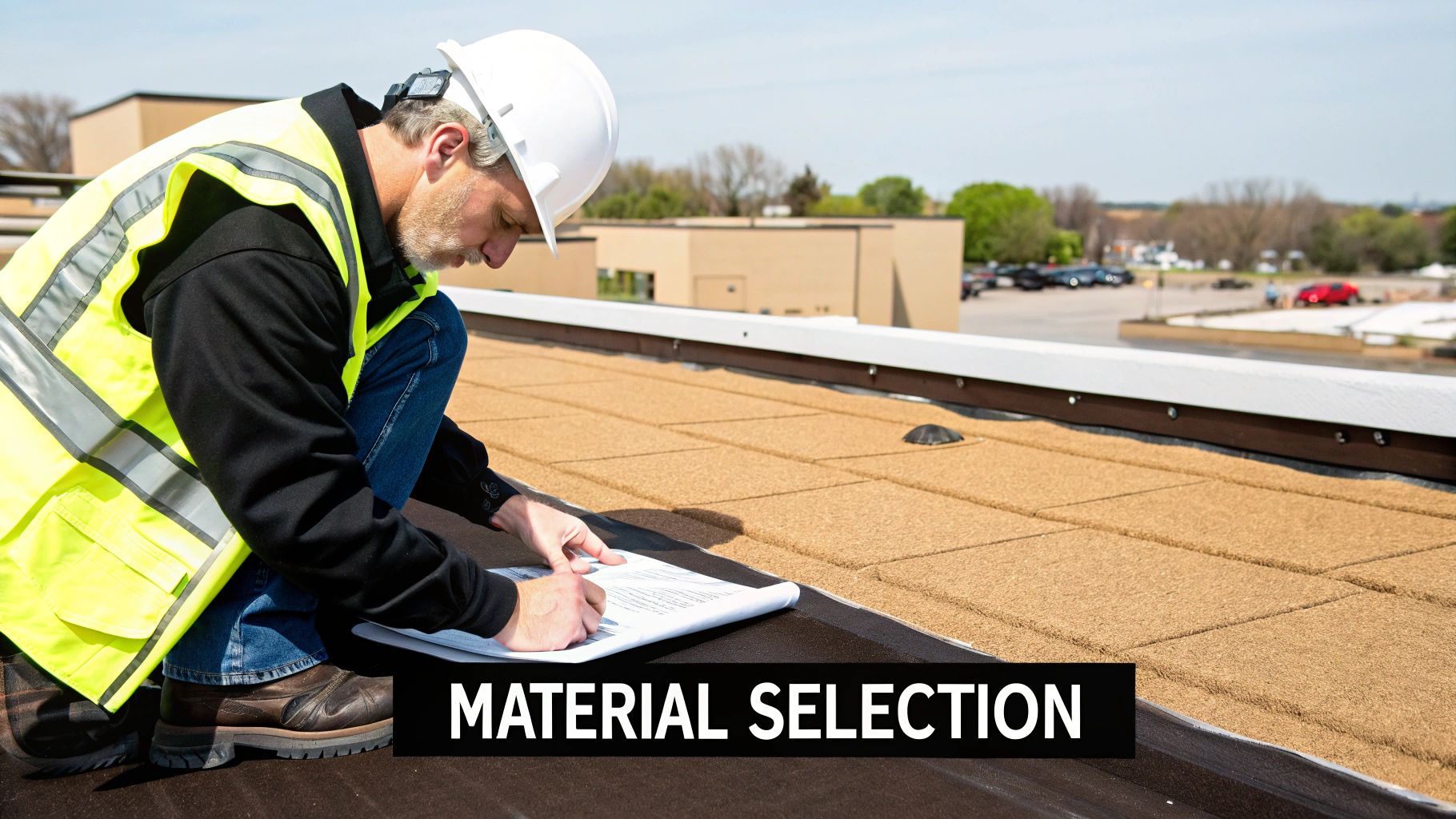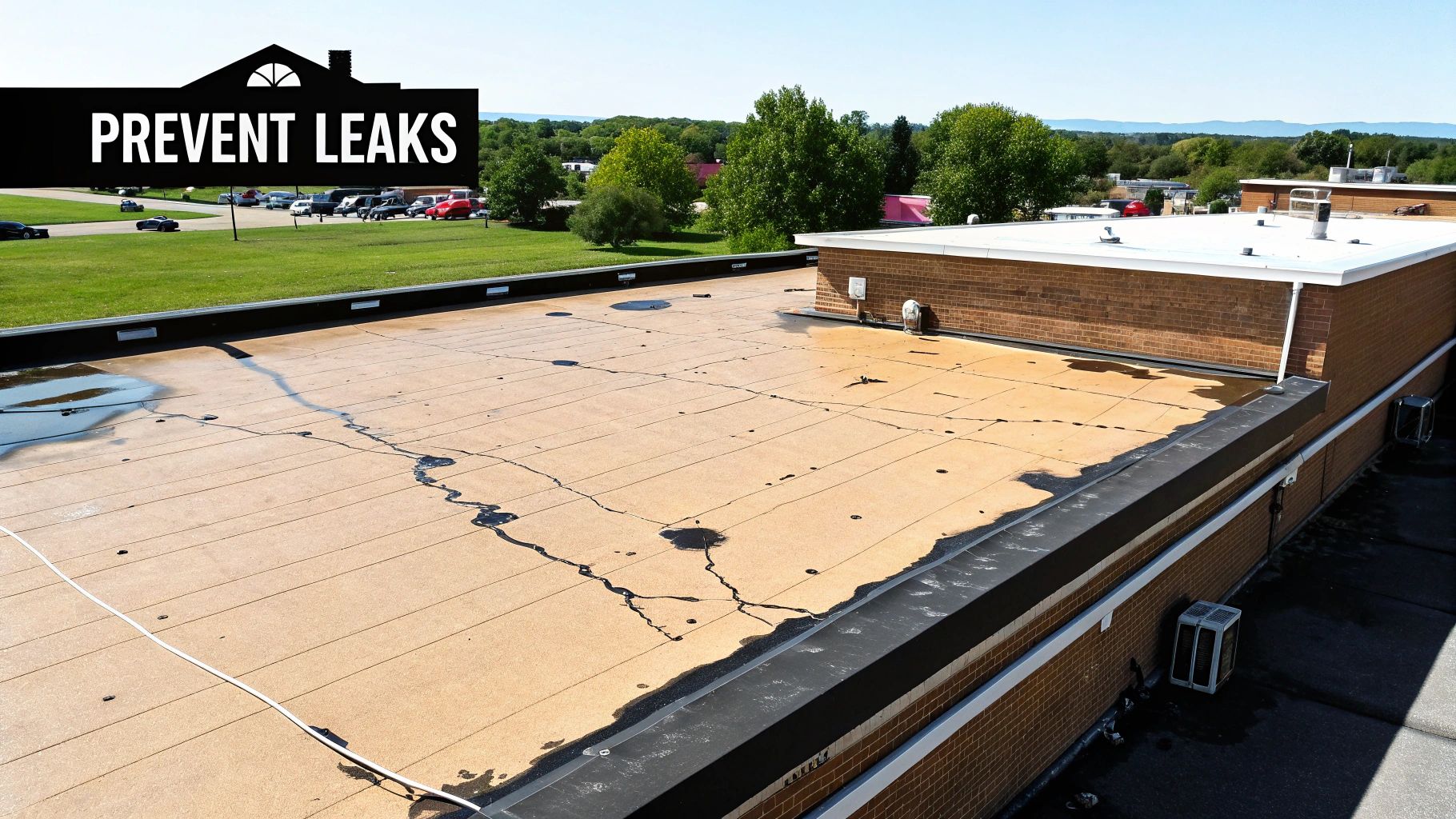That sleek, modern look of a flat roof is undeniably appealing, but here in Florida, it comes with a unique set of rules. The success of a flat roof isn't just about style; it’s a battle against our intense sun, torrential downpours, and hurricane-force winds. To win that battle, you need to choose the right materials and demand a flawless installation.
Understanding the Florida Flat Roof Challenge

Think about the classic triangular roofs you see everywhere else—they use gravity as a free tool to shed water instantly. A flat roof can't do that. Instead, it must be built with a subtle slope, often just a quarter-inch per foot, to guide water toward drains. It's less like a slide and more like a massive, perfectly balanced tray. This engineering detail is where the real Florida challenge begins.
Our weather is a triple threat that puts incredible strain on these systems. The constant UV assault, sudden deluges, and the ever-present risk of hurricanes create a proving ground where only the toughest, best-maintained flat roofs survive.
The Impact of Climate and Age
The Sunshine State's climate ages everything faster, and your roof is at the top of the list. With about 92,000 new roofs going up every year and more than a quarter of existing ones already getting on in years, roof age is a massive factor you must consider for both performance and insurability.
Homes with roofs over 20 years old see a 3% higher loss ratio from wind and hail. That's a number that directly impacts your insurance premiums and risk. To understand the financial implications, you can learn more about how roof age impacts Florida properties.
A flat roof in Florida demands proactive ownership. It’s not a part of your house you can install and forget; it’s an active system that requires regular inspection and maintenance.
A flat roof's biggest enemy in Florida isn't just a single hurricane—it's the daily assault of UV radiation and water. Proper material selection and proactive maintenance are the only defenses that truly work.
Core Concerns for Homeowners
If you have a flat roof or are considering one, your actions should focus on three key areas. Mastering these is the first step to ensuring your roof is a reliable asset, not a constant headache.
- Preventing Leaks: This is your top priority. Since water doesn't roll off, any flaw—a poor seal, a clogged drain, or a small crack—can create "ponding." This standing water will find a way in. Your action plan must include regular drain cleaning and visual inspections for material integrity.
- Ensuring Longevity: The sun's UV rays break down roofing materials, making them brittle. To combat this, select a durable, heat-reflective material from the start. This isn't just an upgrade; it's a necessary strategy for achieving a decent lifespan for flat roofs in Florida.
- Withstanding Storms: During a hurricane, wind creates immense upward suction called "uplift." This force can peel roofing material right off. Your defense is ensuring the installation includes reinforced seams and secure fastening that meet or exceed Florida's high-wind building codes.
Choosing the Best Materials for Your Florida Flat Roof
Picking the right material for your flat roof in Florida is the single most important decision you'll make. This isn't just about covering your home; it's about installing a shield built to handle our state's specific climate threats.
Your choice directly impacts your cooling bills, your home's defense against water, and how long your investment will last. Here, we'll walk through the top contenders—TPO, Modified Bitumen, EPDM, and PVC—focusing on the practical outcomes for a Florida homeowner.
TPO The Energy-Efficient Champion
Thermoplastic Polyolefin, or TPO, has become the go-to material for flat roofs in Florida, and for a clear, practical reason: it can lower your energy bills. A brilliant white TPO membrane acts as a powerful heat shield.
Its surface is highly reflective, bouncing the sun’s punishing UV rays away from your home instead of absorbing them. This directly reduces the heat transferring into your house, meaning your AC runs less. This isn't a small change; it translates into tangible savings on your monthly energy costs.
Beyond energy savings, TPO offers superior leak protection. The seams are not glued but heat-welded, melting them together to form one solid, continuous membrane. This bond is often stronger than the material itself, creating a monolithic barrier against water intrusion—a critical feature for navigating Florida's rainy season.
Modified Bitumen The Tough and Tested Workhorse
If TPO is the modern champion of energy efficiency, then Modified Bitumen is the tough, battle-hardened veteran. This material is an advanced version of traditional asphalt roofing, infused with polymers to make it flexible and durable.
Think of it as asphalt that can stretch and bend. It expands and contracts with Florida's extreme temperature swings without cracking. This elasticity makes it highly resistant to punctures from falling debris or foot traffic, a significant advantage if you have an HVAC unit or other serviceable equipment on your roof.
A key practical benefit of Modified Bitumen is its multi-layered application. This built-in redundancy provides an extra layer of security against leaks, offering peace of mind for any homeowner with a flat roof in Florida.
Installation typically involves using a torch to fuse the layers, creating a tough, waterproof seal. While it doesn't reflect heat like white TPO, you can specify "cool roof" granular surfaces to mitigate some heat absorption. Understanding these components is key, just as you might explore advanced content organization tools to build a well-structured website.

This image highlights a critical action: ensure your roofer builds in a proper slope. Even a subtle angle is crucial for managing heavy rainfall and minimizing maintenance issues.
EPDM and PVC Two More Strong Contenders
While TPO and Mod-Bit are popular, EPDM and PVC offer unique strengths that might make one a better strategic fit for your specific property.
-
EPDM (Ethylene Propylene Diene Monomer): This is a high-performance rubber membrane. Its primary benefits are exceptional durability and a long lifespan; EPDM withstands hail and thermal shock very well. The main action item for Florida is to avoid standard black EPDM, which absorbs heat, and instead specify a version with a reflective top coating.
-
PVC (Polyvinyl Chloride): Often considered a premium material, PVC is a powerhouse known for strength and resistance to fire, chemicals, and ponding water. Like TPO, its seams are heat-welded for a watertight finish. PVC is a smart, though costlier, choice for homes near restaurants or industrial areas where exposure to grease or chemicals is a concern.
Comparing Flat Roof Materials for Florida Homes
To make an informed decision, compare the materials based on performance metrics that matter in our climate. This chart provides an at-a-glance guide to help you choose.
| Material | Average Lifespan (Years) | Heat Reflectivity | Puncture Resistance | Best For |
|---|---|---|---|---|
| TPO | 25 – 30 | Excellent (White) | Good | Action: Prioritize energy efficiency and leak prevention. |
| Modified Bitumen | ~20 | Fair (with cool roof granules) | Excellent | Action: Choose for durability and roofs with foot traffic. |
| EPDM | 25 – 30+ | Poor (Black), Good (Coated) | Very Good | Action: Select for long-term durability and hail resistance. |
| PVC | 20 – 30+ | Excellent (White) | Very Good | Action: Opt for superior chemical and ponding water resistance. |
A well-maintained flat roof in Florida can serve you for decades. Most systems last between 20 to 30 years. A solid Modified Bitumen roof averages around 20 years, while a professionally installed TPO system can push 25 to 30 years. Making the right choice upfront is your best strategy for maximizing your investment.
Fortifying Your Flat Roof Against Hurricanes

When hurricane season arrives, your peace of mind is directly tied to your roof's strength. For homeowners with flat roofs in Florida, this concern is heightened. Unlike pitched roofs that allow wind to flow over them, a flat roof can act like an airplane wing, creating a powerful and dangerous uplift force.
This uplift is your number one enemy. As high-velocity winds speed across the flat surface, the pressure above the roof drops while the air pressure inside your home remains high. This imbalance creates a massive suction force that tries to peel the roof off, starting at the corners and edges.
Without specific fortifications, a flat roof can fail catastrophically during a storm. The solution lies in executing an installation plan that reinforces these weak spots with modern materials and techniques designed for high-wind zones.
The Most Common Hurricane Fail Points
To build a solid defense, you first need to know where the attack will come from. A flat roof rarely fails in the center; the assault almost always begins along the perimeter.
Here are the critical weak points you need to inspect and reinforce:
- Corners and Edges: Aerodynamic forces are most intense here. Wind gets under the membrane and peels it back. Your contractor must use a reinforced fastening pattern in these zones.
- Roof-to-Wall Connections: This is a major stress point. Verify that the connection is secured according to updated building codes.
- Flashing Failure: Flashing seals joints around vents, skylights, and walls. If it's loose or poorly installed, it's an open door for wind and water. This must be inspected and secured.
- Poorly Secured Equipment: Rooftop HVAC units must be anchored to meet hurricane code. If not, they become projectiles that can tear huge holes in your roof. Confirm this with your HVAC and roofing contractors.
The 2004 hurricane season provided a harsh lesson, with widespread roof failures highlighting corner damage on flat and low-slope roofs. This real-world data led to major updates in the Florida Building Code, which now demand stricter standards. You can read about the code changes prompted by hurricane events to understand the engineering behind these requirements.
Actionable Strategies for a Hurricane-Ready Roof
Preparing a flat roof for a hurricane requires a systematic approach. It's about combining stronger materials, superior fastening methods, and smarter drainage to reinforce inherent weaknesses.
A hurricane-ready flat roof is not just built; it's engineered. Every fastener, every seam, and every edge detail must be designed to work together to resist the immense uplift forces generated by high-velocity winds.
Here’s a practical checklist to discuss with your roofer to ensure your roof is storm-ready:
- Enhanced Fastening Patterns: Demand a hurricane-rated installation. This means more fasteners, placed closer together, especially around the perimeter and corners. This distributes the wind load and prevents peeling. For adhered systems, this means using a stronger, hurricane-rated adhesive.
- Heat-Welded Seams: For TPO or PVC roofs, insist on perfect heat-welded seams. This process melts the membrane layers together, creating a single, seamless barrier that is stronger than the material itself, leaving no edge for the wind to grab.
- Secure Flashing and Edge Metal: The metal edging (fascia) is your first line of defense. It must be a heavy-gauge metal securely fastened to meet high-wind standards, anchoring the entire roofing membrane.
- High-Flow Drainage Systems: During a hurricane, your roof will face an incredible amount of rain. Standard drains can be overwhelmed. Actionable upgrades include installing larger drains, adding emergency scuppers (overflows on side walls), and keeping them clear to prevent water from pooling and adding thousands of pounds of stress.
A Practical Maintenance Plan for Your Flat Roof
Proactive maintenance is the best way to maximize the life of your flat roof and avoid costly water damage. A sloped roof sheds debris naturally, but a flat roof acts like a tray, catching and holding everything. A simple, consistent maintenance routine is your number one defense, especially for flat roofs in our demanding Florida climate.
Think of it as preventative care for your home's most critical asset. Your goal is to catch small issues before they escalate into disasters.
Your Seasonal Inspection Checklist
Perform this check at least twice a year: once in late spring before hurricane season, and again in late fall after it passes. It's also a crucial step after any major storm.
Here’s a simple, actionable checklist you can follow:
- Clear All Debris: Use a leaf blower or soft broom to remove all leaves, palm fronds, branches, and dirt. This debris clogs drains and traps moisture, which degrades the roofing material. Never use sharp tools like metal rakes that could puncture the membrane.
- Inspect All Drainage Systems: Once clear, visually inspect your drains, scuppers, and gutters. Ensure they are completely unobstructed so water can escape quickly. A single clogged drain is the leading cause of dangerous ponding water.
- Look for Ponding Water: After a rain, check if any puddles remain on the roof for more than 48 hours. This is ponding water—a major red flag. It signals a drainage problem that requires immediate professional attention. The weight strains your home's structure and the water magnifies the sun's damaging UV rays.
A core part of your plan is ensuring your home is leak-proof. Identifying weak spots early is the most effective way to prevent water intrusion.
Identifying Early Warning Signs
During your visual inspection, train your eye to spot small changes that signal future trouble. Finding these early can save you thousands in repairs.
A small blister or a slightly cracked seam might not look like much, but on a flat roof, it's a breach waiting to happen. In Florida's heat and humidity, even a tiny entry point for moisture can lead to massive damage in no time.
Look for these specific problems:
- Blistering or Bubbling: Raised bumps on the membrane mean air or moisture is trapped underneath, signaling layer separation. These must be professionally repaired.
- Cracked or Peeling Seams: The seams are a classic weak point. Inspect every one, paying close attention to the roof's edges and around any protrusions like pipes or vents.
- Punctures or Tears: Search for any holes or gashes in the membrane, often caused by falling limbs or foot traffic. Even a tiny puncture is a direct path for water.
- Deteriorating Flashing: Check the flashing around skylights, vents, and wall joints. If it’s rusted, loose, or cracked, it's no longer waterproof and must be repaired or replaced.
Knowing When to Call a Professional
While you can handle basic cleaning and visual checks, some problems require an expert. A DIY repair on a membrane blister or a complex seam split can worsen the problem and may void your roof’s warranty.
Immediately call a professional roofer if you see:
- Any ponding water that lasts more than 48 hours.
- Blisters or bubbles larger than a few inches wide.
- Any visible cracks, tears, or punctures in the membrane.
- Loose or damaged flashing around roof penetrations.
A qualified professional will diagnose the root cause—a simple clog versus a serious slope issue—and execute a lasting repair. This partnership is the key to maximizing the lifespan of flat roofs in Florida.
Decoding the Cost of a New Flat Roof
Budgeting for a new flat roof involves more than a simple price-per-square-foot calculation. The final cost is a combination of several critical factors, and understanding them is key to making a smart, long-term investment in your home.
Think of it like buying a car: the price isn't just for the chassis. It includes the engine, safety features, and technology. A new roof is a complete system, and each component impacts both performance and cost.
Key Factors That Drive the Final Cost
A professional estimate will be broken down into line items that reflect your property's specific needs. Understanding these cost drivers will help you compare quotes effectively.
- Roof Size and Complexity: A larger roof requires more materials and labor. Complexity also adds cost. A roof with multiple levels, numerous vents, skylights, or unusual angles requires more detailed work and will cost more than a simple rectangle.
- Material Choice: As discussed, TPO, PVC, and Modified Bitumen have different price points. A premium PVC membrane costs more upfront, but its longer lifespan may offer better long-term value. This is a strategic choice you must make.
- Insulation: Florida building codes mandate specific insulation R-values to resist heat flow. Upgrading your insulation adds to the initial cost but is an investment that pays for itself through lower energy bills.
- Underlying Structure Condition: This is the biggest unknown. Your contractor won't know the condition of the wooden deck until the old roof is removed. If they find rot or damage, it must be replaced before the new roof is installed. You should budget for this potential and necessary additional cost.
Interpreting Your Roofing Estimate
A good estimate is a project roadmap, not just a price. When reviewing a quote, look for signs of quality and professionalism, not just the lowest number.
A low-ball offer that seems too good to be true almost always is. It’s a red flag for cut corners—like reusing old flashing, using substandard materials, or skipping critical prep work—all of which lead to premature roof failure.
Demand these specifics in any estimate you consider:
- Detailed Scope of Work: The document must clearly list everything included. Does it cover a full tear-off of the old roof, debris disposal, replacement of damaged decking, and installation of all new components? Get it in writing.
- Material Specifications: A vague term like "TPO roof" is unacceptable. The quote must specify the brand, type, and thickness, such as "60-mil GAF TPO." This ensures you get exactly what you are paying for.
- Warranty Information: The estimate should clearly outline two warranties: the manufacturer’s warranty on materials and the contractor’s workmanship warranty on the installation. A strong workmanship warranty is a sign that the company stands behind its work.
Before signing, ask two critical questions: "Does this price include pulling all necessary permits?" and "Will this installation meet or exceed current Florida hurricane building codes?" This protects you and ensures your new roof is built to last.
Common Questions About Florida Flat Roofs

When it comes to flat roofs in Florida, homeowners have critical questions. Our climate demands specific solutions. Here are clear, actionable answers to the most common concerns.
Are Flat Roofs a Bad Idea Because of All the Rain?
This is a myth. A flat roof is an excellent choice for Florida—if it is designed and installed with precision by a qualified professional.
The name "flat roof" is misleading. A properly built system has a slight, engineered slope, typically at least a ¼ inch of rise per horizontal foot.
This subtle pitch is a non-negotiable design element. It actively channels the immense amount of water from a Florida downpour toward the drains. Leaks and "ponding water" are not signs that flat roofs are inherently flawed; they are symptoms of a specific failure you can address:
- Action: Verify the initial installation included the correct slope.
- Action: Ensure drains are adequately sized for your roof and kept clear of debris.
- Action: Implement a routine maintenance plan to clear debris and prevent clogs.
With modern waterproof materials like TPO or PVC and consistent upkeep, a flat roof can handle Florida’s wet season without issue.
How Do Flat Roofs Affect My Homeowner's Insurance?
In Florida, insurers scrutinize roofs, focusing on age and materials. A new flat roof, built to code with quality materials by a licensed contractor, is generally insurable without issue.
The challenge arises as the roof ages. A flat roof approaching 15 years old may lead to higher premiums. In some cases, insurers may refuse a policy or offer only "actual cash value" coverage, which does not cover the full replacement cost.
Your most strategic action after a new flat roof installation is to get a wind mitigation inspection. This report officially documents your roof's hurricane-ready features. Submitting this report to your insurance carrier can unlock significant discounts on your premium.
Can I Put Solar Panels on My Flat Roof?
Yes. Flat roofs are often an ideal platform for solar panels. Unlike sloped roofs, panels on a flat roof can be mounted on racks and tilted to the optimal angle for maximum energy production.
However, you must take two crucial actions first. First, hire a structural engineer to confirm your roof can handle the added weight of the solar array. Second, insist that installers use non-penetrating mounting systems. These clamp to the roof structure instead of drilling holes into your waterproof membrane, preventing future leaks.
It is poor planning to install a new 25-year solar system on a roof with only 5-10 years of life left. You will have to pay to remove and reinstall the entire solar array when it's time to replace the roof. Coordinate your roofing and solar projects.
What Is Ponding Water and Why Is It a Major Problem?
Ponding water is any standing water that remains on your roof more than 48 hours after rain. It is not just a puddle; it is an urgent red flag that your drainage system has failed and requires immediate professional inspection.
This standing water creates a vicious cycle of damage:
- Extreme Weight: Water weighs about 5.2 pounds per square foot per inch of depth. A large ponding area adds thousands of pounds of stress to your home's structure.
- Accelerated UV Damage: The water acts as a magnifying glass, focusing the sun's UV rays and dramatically speeding up the breakdown of the roofing membrane beneath it.
- Material Degradation: The standing water collects dirt, creating a sludge that eats away at roofing materials and promotes mildew and algae growth.
Ponding water is a clear signal of a problem—a clogged drain, crushed insulation, or an improper slope. Ignoring it will only lead to more severe and expensive damage.
Navigating the specifics of flat roofs in Florida requires expertise. If you're facing a repair, considering a replacement, or just want a professional assessment of your current roof's condition, the team at Exact Roofing has the experience to guide you. We ensure every project meets Florida's demanding codes for a durable, long-lasting solution. Protect your investment with a professional roofing partner you can trust.

